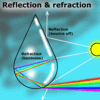 When light changes direction when it passes from one material into
another, it is said to be refracted. Refraction can be observed by putting
a pencil in a glass of water and looking at it from an angle above the
rim. The pencil appears to be in two separate pieces, above and below
the surface of the water. Refraction is caused by light travelling more
slowly in water than in air. Many everyday experiences with light, like
the sparkle of a diamond and rainbows are caused by refraction.
When light changes direction when it passes from one material into
another, it is said to be refracted. Refraction can be observed by putting
a pencil in a glass of water and looking at it from an angle above the
rim. The pencil appears to be in two separate pieces, above and below
the surface of the water. Refraction is caused by light travelling more
slowly in water than in air. Many everyday experiences with light, like
the sparkle of a diamond and rainbows are caused by refraction.
Colours of the rainbow
Chromatic aberration
Because lenses work by refracting light, they also
bend different colours through slightly different angles. This means that
unwanted colours sometimes appear at the edges of bright parts of the image.
Quality cameras and telescopes overcome this aberration by using combinations
of lenses to counteract the effect - these are called achromatic lenses.
This same chromatic aberration can also be seen at the edges of bevelled
mirrors.
Refraction can be put to good use. Refraction is taken into account in the cutting of diamonds, or crystal glass. One of the reasons why these materials can be made to sparkle is that they have a high refractive index. Refractive index is a measure of how much the light changes direction as it passes from one medium into another. To maximise the refraction from diamond and crystals, it's important to make cuts at specific angles so that the light is refracted and reflected many times. A dull diamond is transformed into a sparkling jewel by an expert cutting up to fifty-eight sides, or facets.
| Copyright owned by the State of Victoria (Department of Education and Early Childhood Development). Used with Permission. |
|
|||||||||||||||||||||||||||||||||||||||||||||||||||||||||||||||||||||||||||||||||||||



